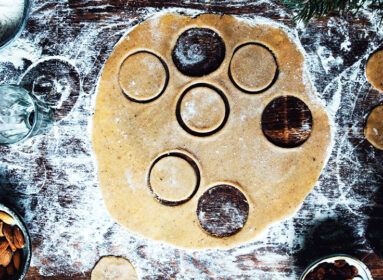
Follow these rules for perfect latkes every time.
By Shannon Sarna (From The Nosher, www.thenosher.com
The time has come for the sacred tradition of frying latkes for Hanukkah. But wait — before you break out your oil and frying pan, make sure you aren’t making any rookie mistakes.
But First, Put On An Apron
Your clothes may get splattered, so wear something you don’t mind getting a bit greasy. You may want to invest in a splatter guard like this for easier clean-up of your kitchen and your shirt. A friend of mine even recommends spreading newspaper on the floor below the stove to catch all those little pieces of potato and splatters of oil.
Don’t Wring Out All the Liquid
I know, I know. Our ancestors have all told us to wring out all the liquid. But several years ago I made latkes with Michelin-star chef Bill Telepan who told me to leave some of that starchy liquid in the mix for the creamiest, crispiest latkes. And he was absolutely right. You should drain off some of the liquid, but if you leave in just enough of that liquid, the difference will astound you.
Never Use Olive Oil
You want to use an oil with a high smoking point; otherwise your latkes will burn. Olive oil is definitely the wrong choice, but there are many other oils you can use such as safflower or sunflower oil, which are food writer Leah Koenig‘s favorite oils for latke frying. I use good old standard vegetable or canola oil.
Make Sure You Test the Oil
My friend and colleague Tamar Fox reminded me to use a chopstick to test the oil before you start frying. Just place a chopstick in the hot oil before you begin frying — it should bubble around the chopstick if it’s ready.
Be Plentiful With Your Oil
Yeah, yeah, we are all watching our weight and health. But when it comes to frying latkes, it ain’t the time to be stingy with the oil. Make sure the bottom of your pan is generously coated with oil, though you don’t want the latkes swimming in oil either. You also should plan to add some oil in between each batch, since the latkes will absorb oil each time.
Don’t Forget to Season
You want to season your latke mixture of course, and don’t forget that potatoes need a lot of salt to really flavor them. But also, as soon as those hot fried latkes come out of the oil, sprinkle with a touch of salt. It really enhances the flavor.
Don’t Just Use Potatoes
There are so many wonderful vegetables to use in place of potatoes. Not to mention that cheese latkes are even more traditional in the Ashkenazi tradition than potato ones. Personally I love using a combination of beet, sweet potato and potato. But there are cauliflower latkes, plantain latkes, ramen latkes and more.
Give the Latkes Space
Never ever ever stack your latkes on top of one another after they have fried, and don’t sit them on top of a paper towel either. Instead, place on top of wire cooling racks placed over a baking sheet to give them space to drain and cool. If latkes sit on one another or a paper towel they will get soggy and lose that coveted crisp.
What to Do with Leftover Potatoes from Chanukah
If you’re left with a ton of potatoes post-Chanukah, don’t fret.
By Shannon Sarna (From The Nosher, www.thenosher.com)
Did you get a little overly zealous buying potatoes at Costco in preparation for Chanukah? Yeah, we know a few people just like you.
If you’re left with a ton of potatoes post-Hanukkah, don’t fret. You can still put those spuds to good use. First of all, the potatoes will keep for several weeks if you have a cool, dark place to store them, like a basement. But if not, here are a few recipes to try:
Mashed Potato Burekas
Ingredients:
1 package phyllo dough, defrosted
leftover mashed potatoes
1 egg + 1 Tbsp. water
dried thyme
freshly ground black pepper
leftover gravy for dipping
Directions:
Preheat oven to 350°.
Beat the egg with 1 Tbsp. of water.
Prepare a baking sheet with parchment paper or a non-stick cooking pad.
Roll out phyllo dough carefully to prevent splitting. I like to divide the layers of the phyllo in half so I can get four sheets instead of two. If the layers seem too brittle and dry, brush with vegetable oil.
Working quickly, cut each sheet horizontally into 4 strips.
Lightly brush a strip with the egg wash. Place a scant teaspoon of mashed potatoes at the right end of the strip and fold the right bottom corner up and to the left to create a triangle shape. Continue wrapping the triangle into the remaining strip, being careful to preserve the triangle shape. Seal the end with egg wash if necessary and place end down on the prepared baking sheet. Repeat this process with the remaining strips.
Lightly brush the tops of the burekas with egg wash and sprinkle with dried thyme and freshly ground black pepper.
Bake for 20 minutes or until golden brown.
Serve with warmed leftover gravy.








 Southern New England Jewish Ledger
Southern New England Jewish Ledger










